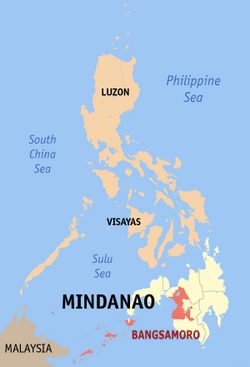Datu Salibo | |
|---|---|
| Municipality of Datu Salibo | |
 Municipal Hall | |
 | |
Location within the Philippines | |
| Coordinates: 7°01′N124°30′E / 7.02°N 124.5°E | |
| Country | Philippines |
| Region | Bangsamoro Autonomous Region in Muslim Mindanao |
| Province | Maguindanao del Sur |
| District | Lone district |
| Founded | July 30, 2009 |
| Barangays | 17 (see Barangays) |
| Government | |
| • Type | Sangguniang Bayan |
| • Mayor | unresolved |
| • Vice Mayor | Omar K. Ali |
| • Representative | Esmael Mangudadatu |
| • Municipal Council | Members |
| • Electorate | 14,900 voters (2025) |
| Area | |
• Total | 150.62 km2 (58.15 sq mi) |
| Elevation | 7.0 m (23.0 ft) |
| Highest elevation | 46 m (151 ft) |
| Lowest elevation | 0 m (0 ft) |
| Population (2024 census) [3] | |
• Total | 21,295 |
| • Density | 141.38/km2 (366.18/sq mi) |
| • Households | 3,244 |
| Economy | |
| • Poverty incidence | 38.16 |
| • Revenue | ₱ 114.3 million (2022) |
| • Assets | ₱ 100.3 million (2022) |
| • Expenditure | ₱ 86.63 million (2022) |
| • Liabilities | ₱ 3.946 million (2022) |
| Service provider | |
| • Electricity | Maguindanao Electric Cooperative (MAGELCO) |
| Time zone | UTC+8 (PST) |
| ZIP code | 9607 |
| PSGC | |
| IDD : area code | +63 (0)64 |
| Native languages | Maguindanao Tagalog |
Datu Salibo, officially the Municipality of Datu Salibo (Maguindanaon: Ingud nu Datu Salibo; Iranun: Inged a Datu Salibo; Tagalog : Bayan ng Datu Salibo), is a municipality in the province of Maguindanao del Sur, Philippines. According to the 2020 census, it has a population of 18,795 people. [5]



